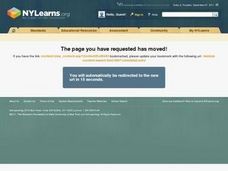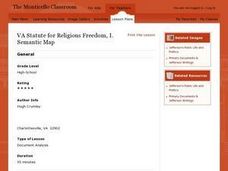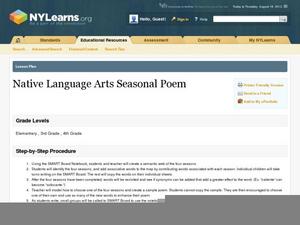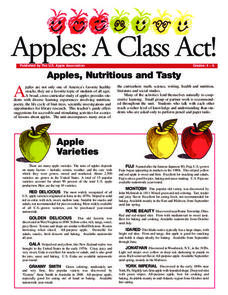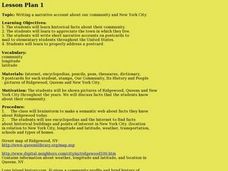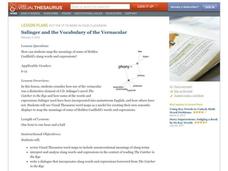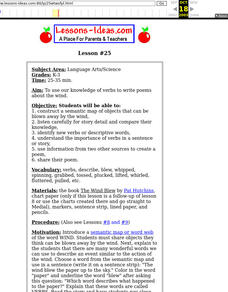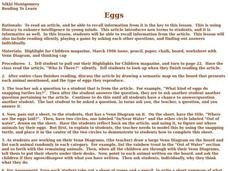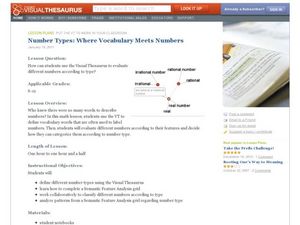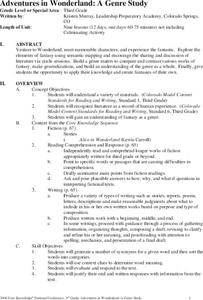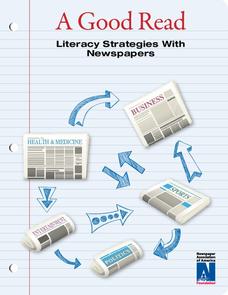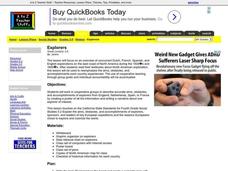Curated OER
Semantic Mapping In Biochemistry
Students create a semantic map utilizing material learned in previous biochemistry lessons. Their maps will include material on the four types of organic compunds previously explored in class.
Florida Center for Reading Research
Vocabulary: Word Analysis, Meaning Map
Lead young learners to understand new vocabulary with this series of word maps. The first of these organizers asks children to determine the definition and provide examples and descriptions of each word with the help of dictionaries,...
Curated OER
VA Statute for Religious Freedom, I. Semantic Map
Students analyze the Virginia Statute for Religious Freedoms and consider its implications. In this document analysis lesson plan, students explore primary and secondary sources regarding the document and create a semantic map that...
Curated OER
Inferring Character Traits
Here is a lesson plan which is "flexible," and can operate as an individual or whole class activity. After reading a book of their choosing, with the use of a semantic map, learners identify character traits. They infer how their...
Curated OER
Native Language Arts Seasonal Poem
Intended for native Spanish speakers, this plan provides an opportunity to create a class semantic web describing the different seasons and listen to Vivaldi's "Four Seasons." Learners will work together to revise their semantic webs,...
US Apple Association
Apples: A Class Act! (Grades 4–6)
Middle schoolers have a bushel of fun as they engage in activities and research core facts about apples. Packed with suggestions for in-class activities and out-of-class research, the colorful 6-page packet is sure to satisfy hungry...
Curated OER
Our community and New York City
Fourth graders research websites to gather information about New York City and the Ridgewood community. For this New York City and Community lesson, 4th graders make a semantic map. Students write short postcards to send to students...
Curated OER
5 W Questions
Second graders practice asking the 5 W questions by reading a Boxcar Children book. In this journalism lesson, 2nd graders read a single story from the Boxcar Children series and answer the 5 W's about each specific chapter. Students...
Curated OER
Salinger and the Vocabulary of the Vernacular
Writers explore vocabulary and expressions used in the English language. They use visual word maps to become aware of the different uses of words which will allow them to more readily interpret texts. Then they listen to/read excerpts...
Curated OER
The Geographic Doctor Seuss
Learners define the term region using semantic mapping, listen to the Dr. Seuss story Yertle the Turtle, and discuss the conflict over borders in the story. They draw a map divided into regions.
Curated OER
Eggs
Help your students practice reading an article to improve their literary skills with new terms and summarizing information. They read silently and then play a game by asking each other questions and finding out answers individually. A...
Curated OER
Number Types: Where Vocabulary Meets Numbers
Rational, irrational, real, natural. All these words can refer to numbers. Who knew? Learners use the Visual Thesaurus and a semantic feature analysis grid to examine the different attributes of numbers. Step-by-step instructions for...
Curated OER
Adventures in Wonderland: A Genre Study
Students explore the concepts of fantasy writing through this nine lessons unit. The unit presents semantic mapping, discussions, comparisons of various works of fantasy, and the opportunity to create their own fantasies.
Curated OER
Weather Watchers
Second graders discuss what weather is and list words that can be used to describe weather. In this science lesson, 2nd graders develop symbols for each type of weather and record the weather for two weeks at the same time and the same...
Curated OER
Holidays: Ramadan and Eid
Learners study ways some holidays are celebrated in this country, and share their experiences, the lesson focuses on Bangla students' celebration of Eid, an important holiday in Bangladesh for the Muslim People. Learners make a class...
Curated OER
Salinger and the Vocabulary of the Vernacular
Students discuss the use of slang expressions in literature. For this literary analysis lesson, students examine the use of slang words and expressions in the popular novel Catcher in the Rye. Students research the various slang terms...
Curated OER
All About Me-I'm My Own Research Project
Third graders see how to do a research project. They understnad how to categorize information about themselves and relate it to information on sea animals for a future research project. This lesson fits in nicely with any unit on animals.
Curated OER
Non-Fiction Animal Picture Books
Students complete a multi-lesson plan unit using research to create their own book about an animal of their choice. After discussing the elements of non-fiction texts, they use internet research to explore an animal of interest to them....
Curated OER
Multicultural Attire
Students research the native attire of a chosen culture, write an essay reflecting the role of the attire in the given culture, and create a significant piece of attire from that culture that be modeled in a fashion show.
Curated OER
Let's Rock
Students investigate the property of rocks and how to distinguish among the different types. They explore the hardness of rocks and perform streak tests to determine mineral color. They classify rocks according to their properties.
Newspaper Association of America
A Good Read
Teach your readers strategies for breaking down informational texts. Pupils develop and implement the tools they'll need to decode texts for the rest of their lives with an informational resource that focuses on the structure and...
Curated OER
Explorers
Young scholars work together to examine Dutch, French, Spanish and English explorers. They create a poster of the information they collected and write about one explore they find most interesting. They share their information with the...
Curated OER
Female Artists
Students listen to excerpts from "History of Women Artists for Students" and discuss the artwork of three artists. They compare and contrast the styles of art and investigate a CD-Rom of famous artists.


